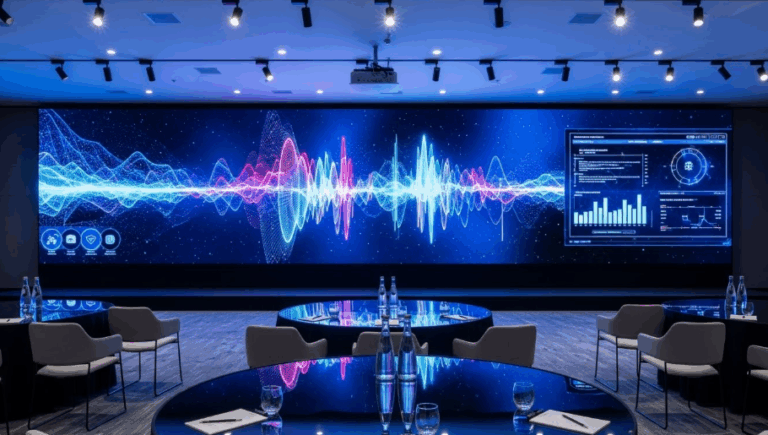LED pitch is the distance between adjacent LED pixels in an LED display, usually in millimeters (mm). LED pitch determines the pixel density of LED display, that is, the number of LED pixels per inch (or per square meter) on the display, and is also one of the important parameters for the resolution and display effect of LED display.
The smaller the LED spacing, the higher the pixel density, the clearer the display effect and the finer the detail of the image and video. The smaller LED spacing is suitable for indoor or close-up viewing applications such as meeting rooms, control rooms, TV walls, etc. The common indoor LED display pitch ranges from 0.8mm to 10mm, with different LED pitch options for different application needs and budgets.

The larger the LED spacing, the lower the pixel density, the display effect is relatively rough, suitable for viewing distance, such as outdoor billboards, sports venues, large public squares, etc. Outdoor LED screen spacing is usually large, generally in more than 10mm, and can even reach tens of millimeters.
Choosing the right LED spacing is very important for the display effect of LED display. Here are some guidelines for choosing LED spacing to help you make informed decisions when purchasing or designing LED displays. 8 free guides to buying outdoor LED screens.
Application and viewing distance: The choice of LED spacing should be determined according to the actual application and viewing distance. For indoor applications, such as meeting rooms, control rooms, etc., small LED spacing is usually required to ensure high resolution and clear display effect. Generally speaking, 0.8mm to 2mm LED spacing is suitable for close viewing occasions; 2mm to 5mm LED spacing is suitable for middle-distance viewing occasions; 5mm to 10mm LED spacing is suitable for distant viewing occasions. And for outdoor applications, such as billboards, stadiums, etc., due to the long viewing distance, you can choose a large LED spacing, usually more than 10mm.
Display requirements: Different applications have different display requirements. If high quality image and video display is required, smaller LED spacing will be more suitable, allowing for higher pixel density and finer image performance. If the display effect requirements are not so strict, the larger LED spacing can also meet the basic display needs, while the price is relatively low.
Budget constraints: LED spacing is usually related to price, smaller LED spacing is usually more expensive, while larger LED spacing is relatively cheaper. When selecting LED spacing, consider budget constraints to ensure that the LED spacing chosen is within an acceptable budget range.
Environmental conditions: The LED display will be affected by environmental conditions, such as lighting conditions, temperature, humidity, etc. When selecting LED spacing, the influence of environmental conditions on the display effect should be considered. For example, a smaller LED pitch may perform better in high light conditions, while a larger LED pitch may be more appropriate in low light conditions.
Maintainability: Smaller LED spacing usually means tighter pixels, which can be difficult to maintain. Therefore, when choosing LED spacing, the maintainability of the display screen should be considered, including the convenience of pixel replacement and repair.
Manufacturing technology: The manufacturing technology of LED displays also influences the choice of LED spacing. As technology continues to evolve, so does the manufacturing of LED displays, and new manufacturing techniques allow for even smaller LED spacing. Micro LED technology, for example, allows for extremely small LED spacing, resulting in higher resolution on a display of the same size. Therefore, the selection of LED spacing should also consider the latest LED manufacturing technology currently on the market.
Scalability: Choosing the right LED spacing is also important if you plan to expand or upgrade your LED display in the future. Smaller LED spacing generally allows for higher pixel density and therefore higher resolution, but may also limit future upgrades and expansions. While larger LED spacing may not be as high resolution, it may be more flexible and can be easily upgraded and expanded.
Display content: Finally, you need to consider the content displayed on the LED display. If you plan to play high-definition video, moving images, or other demanding content on an LED display, the smaller LED spacing often provides a better display. For still images or simple text displays, a larger LED spacing may be sufficient. What if the LED display can’t load the image?
Considering the above factors, the selection of appropriate LED spacing is very important for the performance and display effect of LED display. When purchasing or designing LED displays, it is recommended to comprehensively evaluate the actual application situation, viewing distance, display effect requirements, budget constraints, environmental conditions, maintainability, manufacturing technology and scalability, and select the most appropriate LED spacing to ensure the best display effect of LED displays in your applications.

About Dylan Lian
Marketing Strategic Director at Sostron





